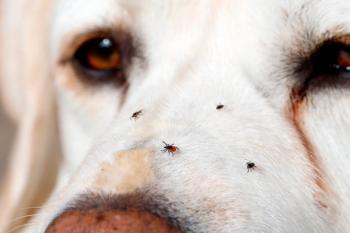
Educating clients on ticks

It is not news that ticks pose a risk to the health of patients, clients, and staff, but how much do you know about them?
During her lecture, Tick Tidbits: Novel Insights & Protection Updates on These Tiny Troublemakers, Kathryn E. Reif, MSPH, PhD, Bailey-Goodwin Endowed Associate Professor in Parasitology Department of Pathobiology, gave an overview of these annoying arachnids, what they are, where they are, and how veterinary professionals can protect patients.
The life of ticks
Ticks are arachnids and are in the same taxonomic class as spiders and scorpions. As adults, they have 8 legs and nymphs, and their body and head are fused. They largely use their Haller’s organ, the tick's first pair of legs, to identify a host. According to Reif, most ticks that infest dogs in the United States are “hard ticks” which is a designation reflecting the scutum, sclerotized cover on the tick’s dorsum. To tell ticks apart, veterinary professionals can use certain simple characteristics of the mouthpart and scutum to differentiate the species that bite people and their pets.
Ticks will only feed typically 3 times in their lifespan, which is 2 to 3 years long, and once in each of their stages of life: larvae, nymphs, and adults. When it comes to ticks that bite patients and clients, they rely on the variety of wildlife species within their local area to maintain populations. Once a tick has found a host, it can live up to 2 weeks on its body while feeding, but most of their lives are spent off the host within their environment.
The risk of ticks
Once the tick identifies a host, it will then crawl to a favorable spot to begin attaching. The tick uses a combination of hypostome and chelicerae to attach and then reinforces its attachment by dispensing salivary proteins that effectively “glue” the tick to its chosen host. Reif explained that when some clients remove a tick, they see what they think is the host’s skin coming off with it. However, this is the residue of the proteins that glue the tick to the host, not the host's skin.
This process of attaching begins can take up to 24 hours, and once completed, the tick will then salivate a complex mixture of salivary proteins to prepare the feeding lesion, recruit blood to the lesion, and hide its presence from the immune system of the host. Leif said killing or incapacitating the tick during this time period is crucial.
“Once it's attached, it's going to secrete [basically] a pharmacy into the skin of the host, several different pharma-coactive proteins that do a lot of different functions…The first couple of proteins will help dissolve the tissue matrix underneath where [the tick is] embedded and recruit the flow of blood cell adhesion that it's creating. What does blood like to do? Clot, [but] don't worry about that,” explained Reif.
“The tick has 7-8 mount novel anti-coagulation proteins to prevent that blood from clotting. The more that tick is attached to that post, the longer that tick is attached to the host. The pathogens are replicating in their salivary glands, which are in their body. And so more and more and more of those pathogens have the potential to be dispensed as the tick continues. And the tick continues feeding and protecting,” she continued.
Reif went on to also let attendees know that risk factors between humans and animals are shared, meaning if a pet tests positive for a tick-borne pathogen, they have been in an area infected with ticks with their owner. It is exceedingly rare for direct transmission of tick-borne pathogens between patients and clients.
Protecting from ticks
Because ticks can threaten the health of patients and clients, most want to know how to protect themselves and their pets. Veterinary professionals can off multiple strategies, especially tick control products. Reif explained if they live in an area with a high number of ticks, clients should check their body and their pet's body. On dogs, certain areas of the body tick such as ears, under the legs, under the collar, and around the tail to name a few. If an owner finds a tick, veterinary professionals can instruct them to use a pointed pair of tweezers to remove it by grasping it as close to the skin as they can get. Then, pull back with steady and even pressure and follow up with that with washing or disinfecting the bite site. Clients could also be instructed to safely save the tick for testing or evidence of a previous bite.
For tick control in patients, there are multiple safe and effective tick control products available to protect and reduce the patient's risk of developing a tick-borne disease. Collars, topicals, and systemically-acting isoxazoline-containing products are the 3 general categories. Topicals are typically applied to the skin of the pet and then distributed through dermal translocation to provide the pet protection. Collars work similarly with active ingredients moving onto the pet’s skin and then migrating all over the body.
Systemically-acting isoxazoline-containing products can depend on the product. They can either be administered to pets orally or topically applied. Reif told attendees to instruct clients to read the label carefully and work with their veterinary team. For tick control in clients, Reif recommended dressing in light-colored and no patterned clothing to help spot a tick quickly and using acaricide as well as skin repellents such as DEET.
Clients will also need to work with their veterinary professionals on deciding which control option is best for their pet and can make this decision based on lifestyle, owner preference, and risk factors of tick-borne diseases. Reif also mentioned that an important factor that should be taken into consideration is how the product works to quickly kill ticks. The faster the kick is killed, the less likely a tick-borne pathogen will be transmitted.
Conclusion
Ticks can cause health issues in both clients and patients. Giving patients a general overview of what exactly ticks is and how they move, plus discussing some common misconceptions, can help veterinary professionals keep their pet parents and patients tick-free.
References
- Reif K. Tick Tidbits: Novel Insights & Protection Updates on These Tiny Troublemakers. Presented at: Fetch dvm360 Conference; August 23-25, 2024; Kansas City, MO.
Newsletter
From exam room tips to practice management insights, get trusted veterinary news delivered straight to your inbox—subscribe to dvm360.






